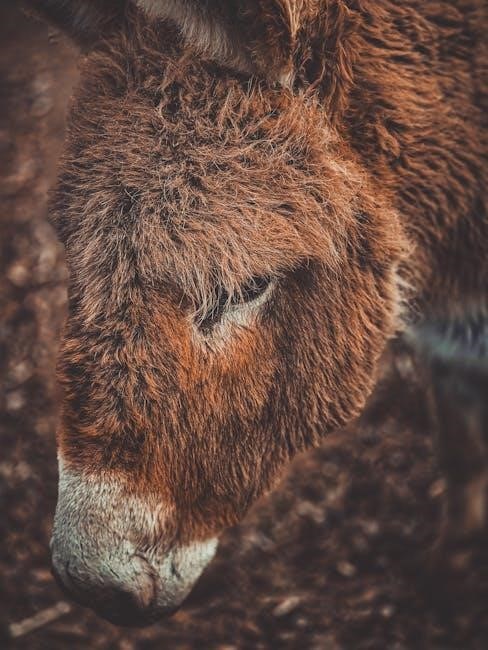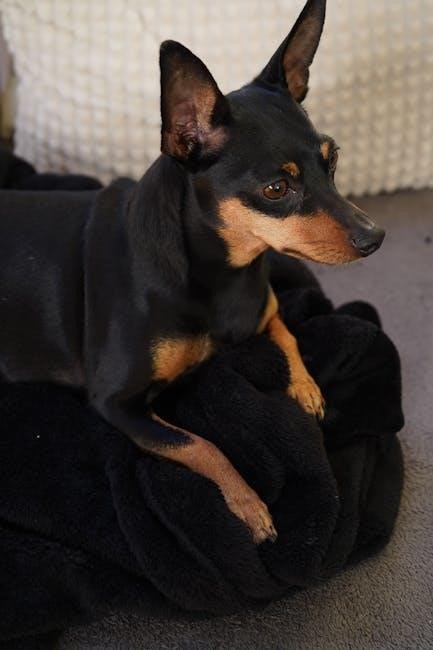
muzzle size guide
Understanding Dog Muzzle Sizes

Choosing the right muzzle size is crucial for your dog’s safety and comfort, ensuring they can pant, drink, and accept treats.
Proper sizing prevents rubbing, chafing, and escape, while allowing essential functions like breathing and temperature regulation.
Different muzzle types—basket, fabric, and silicone—require unique measurement considerations, impacting overall fit and effectiveness.

Online charts and brand-specific guides are valuable resources, but individual dog anatomy always dictates the best fit.
Why Muzzle Size Matters
A correctly sized muzzle is paramount for several critical reasons, extending beyond simply preventing bites. The primary function, of course, is public safety and responsible dog ownership, especially in situations where a dog might react unpredictably due to fear, pain, or territoriality.
However, an ill-fitting muzzle can be detrimental to a dog’s well-being. A muzzle that is too small restricts airflow, hindering panting – a dog’s primary cooling mechanism – potentially leading to overheating and heatstroke. Conversely, a muzzle that is too large allows the dog to potentially slip it off, defeating its purpose.
Comfort is also key. A poorly fitted muzzle can cause chafing, rubbing, and sores around the snout, making the experience unpleasant for the dog and discouraging its use. Proper sizing ensures the dog can still drink water, accept treats, and exhibit natural behaviors, minimizing stress and promoting positive association with the muzzle.
Ultimately, the right size contributes to a safe, comfortable, and effective experience for both the dog and those around them.
Types of Dog Muzzles
Dog muzzles aren’t one-size-fits-all; they come in various designs suited for different purposes and breeds. Understanding these types is crucial for selecting the appropriate size and ensuring a comfortable fit.
Basket muzzles, typically made of plastic or wire, offer the most comprehensive coverage and allow for panting, drinking, and treat-taking. Sizing for basket muzzles focuses on snout length and circumference.
Fabric muzzles, often nylon, are generally used for short-term restraint, like vet visits. These require careful sizing to avoid restricting breathing. They are less ideal for extended wear.
Silicone muzzles, like the TINGOR Soft Basket, combine the benefits of both – allowing for natural behaviors while providing secure restraint. Sizing is similar to basket muzzles, but flexibility requires a snug, yet comfortable fit.
Each type demands a specific approach to measurement, impacting the overall effectiveness and the dog’s comfort level.

Measuring Your Dog for a Muzzle
Accurate measurements—snout length, circumference, and width—are essential for a secure and comfortable muzzle fit, preventing escapes or discomfort.
Use a flexible measuring tape and follow brand-specific guidelines, as sizing can vary between manufacturers and muzzle types.
Snout Length Measurement
Determining your dog’s snout length is a fundamental step in achieving a proper muzzle fit. Begin by measuring from the tip of the nose to the point where the muzzle will sit – typically just below the eyes, where the snout begins to widen.
Ensure the tape measure follows the curve of the snout, avoiding a straight-line measurement which can lead to inaccuracies. It’s helpful to have an assistant hold a treat near the end of the snout to encourage your dog to extend their nose naturally, making the measurement easier and more precise.
Record this measurement in inches or centimeters, depending on the sizing chart provided by the muzzle manufacturer. Remember to round up to the nearest increment if your measurement falls between sizes, as a slightly larger muzzle is preferable to one that is too small and restrictive.
Repeat the measurement a couple of times to confirm consistency and accuracy, minimizing potential errors in the final sizing decision. A precise snout length measurement is critical for ensuring your dog’s comfort and safety while wearing a muzzle.
Snout Circumference Measurement
Measuring the snout circumference is equally vital for a secure and comfortable muzzle fit. Position the tape measure around the widest part of your dog’s snout, typically just in front of their eyes. Ensure the tape is snug but not overly tight, allowing for natural breathing and movement.
Maintain a level tape measure to obtain an accurate circumference reading. Avoid angling the tape, as this can distort the measurement and lead to an ill-fitting muzzle. It’s beneficial to have an assistant help keep the tape in place while you read the measurement.
Record the circumference in inches or centimeters, aligning with the manufacturer’s sizing guide. When in doubt, choose the larger size if your measurement falls between increments, prioritizing comfort and preventing constriction.
Double-check the measurement to confirm its accuracy, as this dimension significantly impacts the muzzle’s overall stability and prevents escape. A correctly measured snout circumference ensures a secure yet comfortable fit for your canine companion.
Width Measurement
Determining the width of your dog’s snout is a crucial step in achieving a proper muzzle fit. Measure the distance between the widest points on either side of your dog’s snout, just below their eyes. This measurement ensures the muzzle accommodates their facial structure without causing discomfort or pressure;
Use a flexible measuring tape and gently conform it to the contours of their face. Avoid pulling the tape too tightly, as this can result in an inaccurate measurement. A slight snugness is acceptable, but prioritize comfort and natural facial expression.
Record the width in inches or centimeters, referencing the specific sizing chart for your chosen muzzle brand. Consider rounding up to the nearest increment if your measurement falls between sizes, ensuring ample space for comfortable breathing and panting.
This measurement, combined with snout length and circumference, provides a comprehensive profile for selecting the ideal muzzle size. A well-fitted muzzle allows for essential functions while maintaining safety and security.

Muzzle Size Charts by Breed Group
Breed-specific charts offer a starting point, but individual variation exists. Small breeds need smaller muzzles, while giant breeds require robust designs.
Medium and large breeds fall within a broader range, demanding precise measurements for optimal fit and comfort.
Small Breed Muzzle Sizes (Under 20 lbs)
For petite pups under 20 pounds, finding a correctly sized muzzle is paramount for both safety and comfort. These breeds, including Chihuahuas, Yorkshire Terriers, Pomeranians, and Miniature Pinschers, require muzzles specifically designed for their smaller snouts and facial structures.

Generally, these muzzles range from size 1 to size 3, but relying solely on weight isn’t sufficient. Accurate snout length and circumference measurements are essential. A typical snout length for these breeds falls between 3 to 5 inches, while the circumference usually ranges from 6 to 8 inches.
Look for muzzles constructed from lightweight, breathable materials like soft nylon or silicone to prevent irritation. Ensure the muzzle allows for sufficient airflow and doesn’t restrict panting, which is crucial for temperature regulation. Always prioritize a snug, but not tight, fit to prevent escape while allowing the dog to open its mouth slightly.
Consider basket muzzles for extended wear, as they allow for drinking and treat dispensing. Regularly check for signs of rubbing or discomfort and adjust the straps accordingly.
Medium Breed Muzzle Sizes (20-50 lbs)
Dogs weighing between 20 and 50 pounds, such as Beagles, Cocker Spaniels, and Border Terriers, typically require muzzle sizes ranging from 3 to 5. However, breed variations significantly impact sizing, making precise measurements crucial.
Snout lengths generally fall between 5 to 7 inches, with circumferences ranging from 8 to 10 inches. Basket muzzles are a popular choice for this size range, offering durability and allowing for essential functions like drinking and panting.
When selecting a muzzle, prioritize a secure fit that prevents slipping or rubbing. Adjustable straps are essential for customization. Ensure the muzzle doesn’t obstruct the dog’s vision or impede natural jaw movement.
Silicone or nylon muzzles are suitable options, offering both comfort and durability. Introduce the muzzle gradually with positive reinforcement to acclimate your dog. Regularly inspect the muzzle for wear and tear and replace it as needed.
Large Breed Muzzle Sizes (50-90 lbs)
For dogs weighing between 50 and 90 pounds, including breeds like Labrador Retrievers, German Shepherds, and Boxers, muzzle sizes generally range from 5 to 7. However, individual variations within these breeds necessitate accurate measurements.

Snout lengths typically measure between 7 to 9 inches, with circumferences spanning 10 to 12 inches. Robust basket muzzles are highly recommended for this weight class, providing both security and allowing for essential canine behaviors.
A properly fitted muzzle should allow for comfortable panting and drinking, without compromising safety. Adjustable straps are vital to achieve a snug, yet non-restrictive fit. Avoid muzzles that put pressure on the eyes or nose.
Durable materials like reinforced nylon or metal are ideal, ensuring longevity and preventing escape. Introduce the muzzle positively and monitor for any signs of discomfort.
Giant Breed Muzzle Sizes (Over 90 lbs)
Dogs exceeding 90 pounds, such as Great Danes, Mastiffs, and Saint Bernards, require specialized, heavy-duty muzzles. Sizes typically fall within the 8 to 10+ inch range, demanding precise measurements for a secure and comfortable fit.
Snout lengths can extend beyond 10 inches, with circumferences often exceeding 14 inches. Extra-large basket muzzles constructed from strong materials like metal or reinforced nylon are essential to prevent escape and ensure durability.
Prioritize muzzles with ample space for panting and drinking, crucial for these large breeds prone to overheating. Adjustable straps and padded nose bridges enhance comfort and prevent chafing.
Regularly inspect the muzzle for wear and tear, and replace it as needed. Positive reinforcement during introduction is key, fostering acceptance and minimizing stress.

Specific Muzzle Brands & Sizing
Brand sizing varies significantly; Baskerville and TINGOR offer distinct charts. Accurate measurements are vital, referencing each brand’s specific guidelines for optimal fit;
Always consult the manufacturer’s size chart, considering snout length, width, and circumference for the best results.
Baskerville Ultra Muzzle Sizing
Baskerville Ultra Muzzles are renowned for their robust design and comfortable fit, but accurate sizing is paramount. The sizing process relies heavily on two key measurements: snout length and snout circumference. To determine the correct size, begin by measuring your dog’s snout length from the tip of the nose to just below the eyes.
Next, measure the circumference of the snout at its widest point, ensuring the measuring tape is snug but not overly tight. Baskerville utilizes a size range system, typically categorized as Extra Small, Small, Medium, Large, and Extra Large. Refer to the official Baskerville sizing chart, which correlates snout length and circumference to the appropriate size.
It’s crucial to note that Baskerville muzzles are designed to allow for a comfortable fit while still preventing biting or grabbing. If your dog’s measurements fall between sizes, it’s generally recommended to choose the larger size to avoid constriction. Always prioritize comfort and ensure the muzzle doesn’t impede breathing or panting.
Soft Basket Silicone Muzzle Sizing (TINGOR)
TINGOR Soft Basket Silicone Muzzles prioritize comfort and functionality, requiring precise sizing for optimal effectiveness. Sizing for these muzzles centers around snout length and circumference, similar to traditional basket muzzles, but with considerations for the flexible silicone material. Begin by accurately measuring your dog’s snout length from the nose tip to the point beneath their eyes.
Then, measure the snout’s circumference at its widest point, ensuring a snug, but not restrictive, fit. TINGOR typically offers sizes ranging from 1 to 5, corresponding to specific measurement ranges. Consult the official TINGOR sizing chart to match your dog’s measurements to the appropriate size.
Due to the silicone’s flexibility, a slightly larger size is often preferable to avoid excessive pressure. Ensure the muzzle allows for uninhibited panting and drinking, crucial for your dog’s well-being. Always supervise your dog when initially introducing the muzzle to confirm a comfortable and secure fit.

Adjusting and Fitting the Muzzle
Secure straps are vital for a snug, yet comfortable fit, preventing escape while allowing natural behaviors like panting and drinking.
Gradual acclimation is key, using positive reinforcement to associate the muzzle with rewards and positive experiences.
Ensuring Proper Fit & Comfort
A correctly fitted muzzle allows your dog to open their mouth sufficiently to pant and drink water comfortably. Observe your dog closely; they shouldn’t be able to remove the muzzle by pawing at it or backing out of it.
Check for rubbing or chafing, especially around the bridge of the nose, eyes, and mouth. Redness or sores indicate an improper fit and require adjustment or a different muzzle size. Ensure the muzzle doesn’t restrict breathing or impede vision.
The muzzle should sit securely without being overly tight. You should be able to comfortably slide a finger or two under the straps. Regularly inspect the muzzle for wear and tear, replacing it if damaged. Positive reinforcement during fitting is crucial; reward your dog with treats and praise to create a positive association.
Remember, comfort is paramount for acceptance and effective use.
Signs of an Improperly Fitted Muzzle
Several indicators suggest a muzzle doesn’t fit correctly. Constant pawing at the muzzle is a clear sign of discomfort, as is persistent attempts to rub it off against surfaces. Excessive drooling or difficulty panting indicates restricted airflow, potentially leading to overheating.
Look for redness, sores, or chafing around the nose, lips, or eyes. These are signs of friction and pressure. If your dog struggles to drink water while wearing the muzzle, it’s likely too tight or restricts jaw movement.
A muzzle that shifts excessively during normal activity is also ill-fitting. Observe for signs of distress, such as whining, shaking, or trying to escape the muzzle. Ignoring these signs can cause anxiety and discomfort for your dog. Adjust the straps or consider a different size or style immediately.

Materials and Their Impact on Size
Muzzle material significantly influences fit; basket muzzles offer space, while fabric options may require precise sizing.
Silicone provides flexibility, but accurate measurements are still vital for optimal comfort and secure restraint.
Basket Muzzles
Basket muzzles, often constructed from plastic or coated metal, are renowned for their durability and allow dogs to pant, drink, and even accept treats comfortably.
Sizing for basket muzzles typically focuses on snout length and circumference, but width is also a critical factor to prevent rubbing.
Measure the length from the tip of the nose to just below the eyes, and the circumference at the widest point of the snout.
Ensure ample space—around one to two finger widths—between the muzzle and the dog’s nose, preventing pressure sores and allowing for natural movement.
Consider the breed’s muzzle shape; brachycephalic breeds (like Pugs) require specialized basket muzzles designed for their shorter snouts.
Properly fitted basket muzzles should not restrict breathing or vision, and the dog should be able to open its mouth slightly.
Always supervise your dog when wearing a basket muzzle, especially during initial acclimation.
Fabric Muzzles
Fabric muzzles, typically made of nylon or mesh, are often used for temporary restraint or to prevent licking, but require careful sizing to ensure comfort and safety.
Unlike basket muzzles, fabric muzzles generally don’t allow for drinking or treat-taking while worn, making them less suitable for extended periods.
Sizing primarily involves measuring the circumference of the snout and under the chin, ensuring a snug but not constricting fit.
The muzzle should cover the dog’s mouth completely without pressing against the nostrils, hindering breathing.
Look for adjustable straps to fine-tune the fit, preventing the muzzle from slipping or rubbing;
Regularly check for signs of discomfort, such as excessive pawing at the muzzle or difficulty breathing.
Fabric muzzles are best suited for short-term use under direct supervision, and are not ideal for active dogs or hot weather.
